
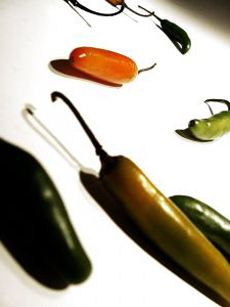 Combine chiles with cocoa for one of this year’s hot flavor combos—no pun intended! Photo by A. Carlos Herrera | SXC.
Combine chiles with cocoa for one of this year’s hot flavor combos—no pun intended! Photo by A. Carlos Herrera | SXC.
January 2008
|
 |
Flavor Trends For 2008
Top Spice Pairings That Will Make Your Dishes Cutting Edge...With Great Recipes
CAPSULE REPORT: Looking for gourmet excitement this year? McCormick, the world’s largest spice company, has done the heavy lifting—figuring out exciting combinations. You just need to try the recipes. Their Top 10 Flavor Pairings for 2008 are a bit exotic, certainly gourmet, and sure to put inspired new dishes on your table. After reviewing the list below, you can click through to a delicious recipe for each flavor pairing.
How does a spice company decide what’s hot? They have an extensive network of researchers, trend experts, chefs, food technologists and sensory analysts. Together with leading restaurant chefs, cookbook authors and TV food personalities, they are constantly exploring new ways to experience flavor. When they hit on a hot combination—like lemon grass and lychee or red curry and masa—they know it.
Influencing the flavors of 2008 are America’s focus on health and wellness, the movement to authentic ingredients and global cooking techniques, and local and artisan food. McCormick explored these and other trends to develop the top 10 flavor pairings for 2008. See which one of the following you’d like to try first:
Allspice and Exotic Meats. Allspice, also called Jamaican pepper, is the dried fruit of 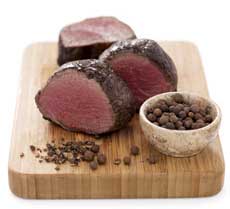 the Pimenta dioica plant. The fruit is picked when it is green and traditionally dried in the sun, at which point it resembles large brown peppercorns. It has the heat and spiciness of black peppercorns (Piper nigrum), with added flavors of cinnamon, cloves and nutmeg—hence the name, allspice. Using allspice instead black pepper is one level of experimentation, but adding it to exotic meets like bison (usually called, incorrectly, buffalo) and ostrich advances the needle. Try these Spice-Rubbed Buffalo Steaks with Fig Balsamic Reduction (photo at right). See our article on varietal peppercorns for more about allspice. And take a look at our favorite bison, Blackwing Bison, which includes an explanation of how bison came to be called “buffalo.” Bison is an extremely lean meat, by the way—absolutely delicious and a healthier red meat choice. the Pimenta dioica plant. The fruit is picked when it is green and traditionally dried in the sun, at which point it resembles large brown peppercorns. It has the heat and spiciness of black peppercorns (Piper nigrum), with added flavors of cinnamon, cloves and nutmeg—hence the name, allspice. Using allspice instead black pepper is one level of experimentation, but adding it to exotic meets like bison (usually called, incorrectly, buffalo) and ostrich advances the needle. Try these Spice-Rubbed Buffalo Steaks with Fig Balsamic Reduction (photo at right). See our article on varietal peppercorns for more about allspice. And take a look at our favorite bison, Blackwing Bison, which includes an explanation of how bison came to be called “buffalo.” Bison is an extremely lean meat, by the way—absolutely delicious and a healthier red meat choice.
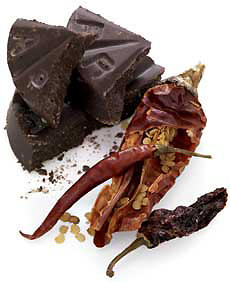 Chile and Cocoa. The is popular flavor combination of ancient Mesoamerica is resurrected in an expanded context. The Mayas and Aztecs, who were the original cultivators of cacao tree that provides us with cocoa and chocolate, only knew cacao in its beverage form. They flavored their tepid cocoa beverage with chiles and other spices (it didn’t become hot cocoa until it was brought back to Spain by the Conquistadors). Chile and Cocoa. The is popular flavor combination of ancient Mesoamerica is resurrected in an expanded context. The Mayas and Aztecs, who were the original cultivators of cacao tree that provides us with cocoa and chocolate, only knew cacao in its beverage form. They flavored their tepid cocoa beverage with chiles and other spices (it didn’t become hot cocoa until it was brought back to Spain by the Conquistadors).
Today, the combination of chile and cocoa flavors works in everything from barbecue to ice cream to, yes, chocolate bars and hot chocolate, delivering complex heat, depth, dimension and richness. Try these Cocoa Chile Pork Ribs.
 Coriander and Coconut Water. Coriander, the dried seed of the herb cilantro (which is also called coriander), is not just an herb for Mexican and Pacific Rim dishes. The seed is a chameleon-like spice that brings forth light, clean flavors. Coriander and Coconut Water. Coriander, the dried seed of the herb cilantro (which is also called coriander), is not just an herb for Mexican and Pacific Rim dishes. The seed is a chameleon-like spice that brings forth light, clean flavors.
Pairing coriander with coconut water, another flavor of the Asian tropics, adds a taste of the tropics to everything from rice to cocktails. Several brands of coconut water are readily available at specialty food stores. Try this recipe for Chilled Papaya and Watermelon Soup with Lemon Coriander Cream.
Lemongrass and Lychee. For decades, these two flavors from the Pacific Rim have 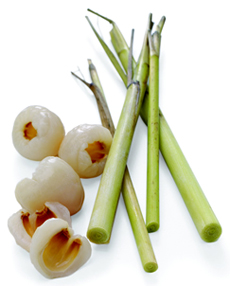 been entrancing Americans in Asian cuisines. Lemongrass is actually a grass with a citrus flavor. It’s popular in Indonesian, Malaysian, Thai, Vietnamese and other Pacific Rim cuisines, as well as in Caribbean cooking. Lychee (also spelled litchi, and pronounced LEE-chee) is the fruit of a Chinese evergreen tree—the bright red exterior is peeled away to revel the milky white fruit inside. been entrancing Americans in Asian cuisines. Lemongrass is actually a grass with a citrus flavor. It’s popular in Indonesian, Malaysian, Thai, Vietnamese and other Pacific Rim cuisines, as well as in Caribbean cooking. Lychee (also spelled litchi, and pronounced LEE-chee) is the fruit of a Chinese evergreen tree—the bright red exterior is peeled away to revel the milky white fruit inside.
The exotic flavors of each create wonderful fusion dishes. Start by enhancing that everyday tuna steak with this recipe for Seared Sesame Tuna with Lemon Grass and Lychee Coulis.
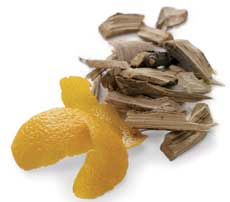 Orange Peel and Natural Wood. Here’s a yin and yang sensation: zingy, tangy orange peel paired with the smokiness of wood. Think of using this combination with beef, chicken, duck, lamb or pork. While the combination of orange peel and smoke seems a natural for Chinese dishes, they can do wonders for all-American favorites like burgers. Try this recipe for a Wood-Smoked Chicken Burgers with Orange Peel Aioli. They’re almost guaranteed to become a favorite in your home. Orange Peel and Natural Wood. Here’s a yin and yang sensation: zingy, tangy orange peel paired with the smokiness of wood. Think of using this combination with beef, chicken, duck, lamb or pork. While the combination of orange peel and smoke seems a natural for Chinese dishes, they can do wonders for all-American favorites like burgers. Try this recipe for a Wood-Smoked Chicken Burgers with Orange Peel Aioli. They’re almost guaranteed to become a favorite in your home.
 Oregano and Heirloom Beans. Nutrition-dense beans, a comfort food, combine with a favorite flavor-intense herb, oregano, to create a tasty, antioxidant powerhouse. With so many beautiful heirloom bean varieties available online and at farmers markets, you can impress your family and friends with visual presentation as well as flavor. We like to keep them in pretty bowls as table decoration, as shown in the photo at the right; and they look just beautiful in glass canisters. But don’t just buy them to enjoy their beauty: Enjoy this recipe for Cornmeal Crusted Scallops with Heirloom Bean and Oregano Succotash. We think it will become another family favorite. Oregano and Heirloom Beans. Nutrition-dense beans, a comfort food, combine with a favorite flavor-intense herb, oregano, to create a tasty, antioxidant powerhouse. With so many beautiful heirloom bean varieties available online and at farmers markets, you can impress your family and friends with visual presentation as well as flavor. We like to keep them in pretty bowls as table decoration, as shown in the photo at the right; and they look just beautiful in glass canisters. But don’t just buy them to enjoy their beauty: Enjoy this recipe for Cornmeal Crusted Scallops with Heirloom Bean and Oregano Succotash. We think it will become another family favorite.
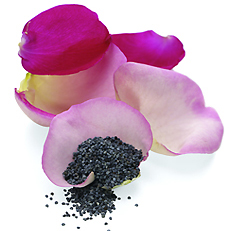 Poppy Seed and Rose. In North Africa and the Middle East, rose is a popular ingredient—as petals, essence (like extract), rose water. Here, you can find rose petal jams and, if you’re lucky, the wonderful rose water sorbet called faludeh. Poppy seeds are also Middle Eastern in influence; here, an elegant and sensuous pairing evokes the exotic while bringing something fresh and new to the table. You can use this combination in both sweet and savory preparations. Try it first in this glamorous recipe for Field Salad with Strawberries, Kumquats and Rose Petals. Poppy Seed and Rose. In North Africa and the Middle East, rose is a popular ingredient—as petals, essence (like extract), rose water. Here, you can find rose petal jams and, if you’re lucky, the wonderful rose water sorbet called faludeh. Poppy seeds are also Middle Eastern in influence; here, an elegant and sensuous pairing evokes the exotic while bringing something fresh and new to the table. You can use this combination in both sweet and savory preparations. Try it first in this glamorous recipe for Field Salad with Strawberries, Kumquats and Rose Petals.
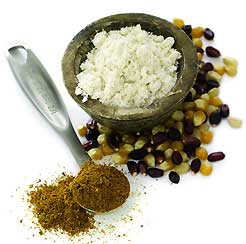 Red Curry and Masa. Thai red curry is most commonly used to make a popular dish based on a thick, coconut milk-based sauce (that also includes some fish sauce). It is served with beef, chicken, duck, pork, shrimp or tofu. On the opposite side of the Pacific Ocean, masa is the finely ground corn used to make tortillas, tamales and many other Latin dishes. While the two ingredients might seem an ocean apart, together they create a unique flavor experience. We hope you enjoy this special fusion recipe for Red Curry Shrimp and Plantain Tempura. Red Curry and Masa. Thai red curry is most commonly used to make a popular dish based on a thick, coconut milk-based sauce (that also includes some fish sauce). It is served with beef, chicken, duck, pork, shrimp or tofu. On the opposite side of the Pacific Ocean, masa is the finely ground corn used to make tortillas, tamales and many other Latin dishes. While the two ingredients might seem an ocean apart, together they create a unique flavor experience. We hope you enjoy this special fusion recipe for Red Curry Shrimp and Plantain Tempura.
Rubbed Sage and Rye Whiskey. Two powerful, American flavors call up fall and winter dishes, from soups to breads to condiments and sauces to stuffings. Sage is a  wonderful culinary herb, not used often enough in most households. It is an excellent complement to the dry, gutsy nature of rye whiskey, a historic American distillate poised for a great renaissance. Rye was the prevalent whiskey of the northeastern U.S. until the Prohibition; after the repeal of Prohibition, it never recovered, as other spirits like Scotch and Bourbon gained in popularity. It is distilled from at least 51% rye mash, as opposed to at least 51% corn mash for Bourbon; it is similar to Bourbon though a bit more peppery and bitter. Read more about the different types of whiskey. While elegant dishes can be made from using rye and sage accents, here’s a recipe for an everyday “Rye on Rye” Roast Beef Panini. wonderful culinary herb, not used often enough in most households. It is an excellent complement to the dry, gutsy nature of rye whiskey, a historic American distillate poised for a great renaissance. Rye was the prevalent whiskey of the northeastern U.S. until the Prohibition; after the repeal of Prohibition, it never recovered, as other spirits like Scotch and Bourbon gained in popularity. It is distilled from at least 51% rye mash, as opposed to at least 51% corn mash for Bourbon; it is similar to Bourbon though a bit more peppery and bitter. Read more about the different types of whiskey. While elegant dishes can be made from using rye and sage accents, here’s a recipe for an everyday “Rye on Rye” Roast Beef Panini.
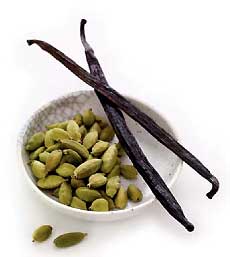 Vanilla Bean and Cardamom. This is an exotic and luxurious flavor match, long used by a handful of sophisticated pastry chefs. It can also be used in sauces for fish and chicken; but we’re offering you neither sophistication nor savory in these two fun recipes: Vanilla Cardamom Whoopie Pies and Vanilla Cardamom Milk Shake Shooters. Enjoy them singly or together; either will have you exclaiming, “Whoopie!” Vanilla Bean and Cardamom. This is an exotic and luxurious flavor match, long used by a handful of sophisticated pastry chefs. It can also be used in sauces for fish and chicken; but we’re offering you neither sophistication nor savory in these two fun recipes: Vanilla Cardamom Whoopie Pies and Vanilla Cardamom Milk Shake Shooters. Enjoy them singly or together; either will have you exclaiming, “Whoopie!”
For more information about spices, visit McCormick.com.

|





 the Pimenta dioica plant. The fruit is picked when it is green and traditionally dried in the sun, at which point it resembles large brown peppercorns. It has the heat and spiciness of black peppercorns (Piper nigrum), with added flavors of cinnamon, cloves and nutmeg—hence the name, allspice. Using allspice instead black pepper is one level of experimentation, but adding it to exotic meets like bison (usually called, incorrectly, buffalo) and ostrich advances the needle. Try these
the Pimenta dioica plant. The fruit is picked when it is green and traditionally dried in the sun, at which point it resembles large brown peppercorns. It has the heat and spiciness of black peppercorns (Piper nigrum), with added flavors of cinnamon, cloves and nutmeg—hence the name, allspice. Using allspice instead black pepper is one level of experimentation, but adding it to exotic meets like bison (usually called, incorrectly, buffalo) and ostrich advances the needle. Try these  Chile and Cocoa. The is popular flavor combination of ancient Mesoamerica is resurrected in an expanded context. The Mayas and Aztecs, who were the original cultivators of cacao tree that provides us with cocoa and chocolate, only knew cacao in its beverage form. They flavored their tepid cocoa beverage with chiles and other spices (it didn’t become hot cocoa until it was brought back to Spain by the Conquistadors).
Chile and Cocoa. The is popular flavor combination of ancient Mesoamerica is resurrected in an expanded context. The Mayas and Aztecs, who were the original cultivators of cacao tree that provides us with cocoa and chocolate, only knew cacao in its beverage form. They flavored their tepid cocoa beverage with chiles and other spices (it didn’t become hot cocoa until it was brought back to Spain by the Conquistadors).  Coriander and Coconut Water. Coriander, the dried seed of the herb cilantro (which is also called coriander), is not just an herb for Mexican and Pacific Rim dishes. The seed is a chameleon-like spice that brings forth light, clean flavors.
Coriander and Coconut Water. Coriander, the dried seed of the herb cilantro (which is also called coriander), is not just an herb for Mexican and Pacific Rim dishes. The seed is a chameleon-like spice that brings forth light, clean flavors.  been entrancing Americans in Asian cuisines. Lemongrass is actually a grass with a citrus flavor. It’s popular in Indonesian, Malaysian, Thai, Vietnamese and other Pacific Rim cuisines, as well as in Caribbean cooking. Lychee (also spelled litchi, and pronounced LEE-chee) is the fruit of a Chinese evergreen tree—the bright red exterior is peeled away to revel the milky white fruit inside.
been entrancing Americans in Asian cuisines. Lemongrass is actually a grass with a citrus flavor. It’s popular in Indonesian, Malaysian, Thai, Vietnamese and other Pacific Rim cuisines, as well as in Caribbean cooking. Lychee (also spelled litchi, and pronounced LEE-chee) is the fruit of a Chinese evergreen tree—the bright red exterior is peeled away to revel the milky white fruit inside.  Orange Peel and Natural Wood. Here’s a yin and yang sensation: zingy, tangy orange peel paired with the smokiness of wood. Think of using this combination with beef, chicken, duck, lamb or pork. While the combination of orange peel and smoke seems a natural for Chinese dishes, they can do wonders for all-American favorites like burgers. Try this recipe for a
Orange Peel and Natural Wood. Here’s a yin and yang sensation: zingy, tangy orange peel paired with the smokiness of wood. Think of using this combination with beef, chicken, duck, lamb or pork. While the combination of orange peel and smoke seems a natural for Chinese dishes, they can do wonders for all-American favorites like burgers. Try this recipe for a  Oregano and Heirloom Beans. Nutrition-dense beans, a comfort food, combine with a favorite flavor-intense herb, oregano, to create a tasty, antioxidant powerhouse. With so many beautiful heirloom bean varieties available online and at farmers markets, you can impress your family and friends with visual presentation as well as flavor. We like to keep them in pretty bowls as table decoration, as shown in the photo at the right; and they look just beautiful in glass canisters. But don’t just buy them to enjoy their beauty: Enjoy this recipe for
Oregano and Heirloom Beans. Nutrition-dense beans, a comfort food, combine with a favorite flavor-intense herb, oregano, to create a tasty, antioxidant powerhouse. With so many beautiful heirloom bean varieties available online and at farmers markets, you can impress your family and friends with visual presentation as well as flavor. We like to keep them in pretty bowls as table decoration, as shown in the photo at the right; and they look just beautiful in glass canisters. But don’t just buy them to enjoy their beauty: Enjoy this recipe for  Poppy Seed and Rose. In North Africa and the Middle East, rose is a popular ingredient—as petals, essence (like extract), rose water. Here, you can find rose petal jams and, if you’re lucky, the wonderful rose water sorbet called faludeh. Poppy seeds are also Middle Eastern in influence; here, an elegant and sensuous pairing evokes the exotic while bringing something fresh and new to the table. You can use this combination in both sweet and savory preparations. Try it first in this glamorous recipe for
Poppy Seed and Rose. In North Africa and the Middle East, rose is a popular ingredient—as petals, essence (like extract), rose water. Here, you can find rose petal jams and, if you’re lucky, the wonderful rose water sorbet called faludeh. Poppy seeds are also Middle Eastern in influence; here, an elegant and sensuous pairing evokes the exotic while bringing something fresh and new to the table. You can use this combination in both sweet and savory preparations. Try it first in this glamorous recipe for  Red Curry and Masa. Thai red curry is most commonly used to make a popular dish based on a thick, coconut milk-based sauce (that also includes some fish sauce). It is served with beef, chicken, duck, pork, shrimp or tofu. On the opposite side of the Pacific Ocean, masa is the finely ground corn used to make tortillas, tamales and many other Latin dishes. While the two ingredients might seem an ocean apart, together they create a unique flavor experience. We hope you enjoy this special fusion recipe for
Red Curry and Masa. Thai red curry is most commonly used to make a popular dish based on a thick, coconut milk-based sauce (that also includes some fish sauce). It is served with beef, chicken, duck, pork, shrimp or tofu. On the opposite side of the Pacific Ocean, masa is the finely ground corn used to make tortillas, tamales and many other Latin dishes. While the two ingredients might seem an ocean apart, together they create a unique flavor experience. We hope you enjoy this special fusion recipe for  wonderful culinary herb, not used often enough in most households. It is an excellent complement to the dry, gutsy nature of rye whiskey, a historic American distillate poised for a great renaissance. Rye was the prevalent whiskey of the northeastern U.S. until the Prohibition; after the repeal of Prohibition, it never recovered, as other spirits like Scotch and Bourbon gained in popularity. It is distilled from at least 51% rye mash, as opposed to at least 51% corn mash for Bourbon; it is similar to Bourbon though a bit more peppery and bitter. Read more about the
wonderful culinary herb, not used often enough in most households. It is an excellent complement to the dry, gutsy nature of rye whiskey, a historic American distillate poised for a great renaissance. Rye was the prevalent whiskey of the northeastern U.S. until the Prohibition; after the repeal of Prohibition, it never recovered, as other spirits like Scotch and Bourbon gained in popularity. It is distilled from at least 51% rye mash, as opposed to at least 51% corn mash for Bourbon; it is similar to Bourbon though a bit more peppery and bitter. Read more about the  Vanilla Bean and Cardamom. This is an exotic and luxurious flavor match, long used by a handful of sophisticated pastry chefs. It can also be used in sauces for fish and chicken; but we’re offering you neither sophistication nor savory in these two fun recipes:
Vanilla Bean and Cardamom. This is an exotic and luxurious flavor match, long used by a handful of sophisticated pastry chefs. It can also be used in sauces for fish and chicken; but we’re offering you neither sophistication nor savory in these two fun recipes: